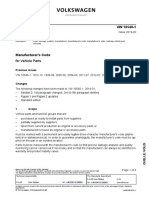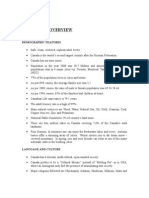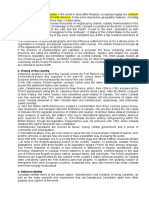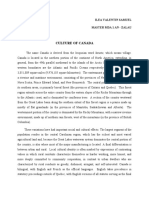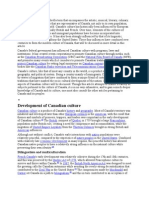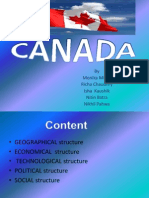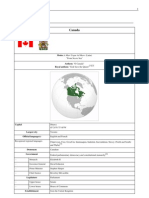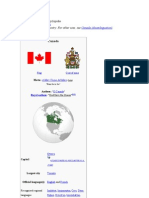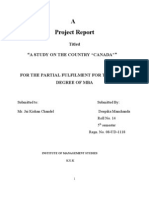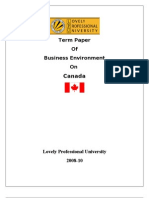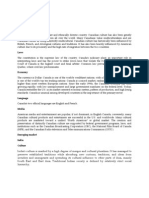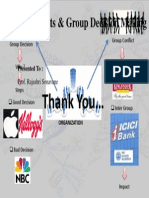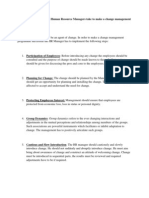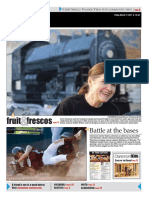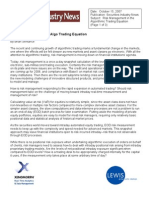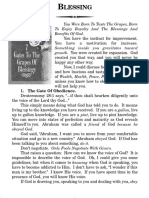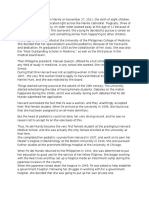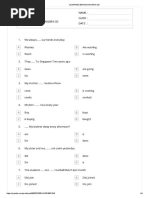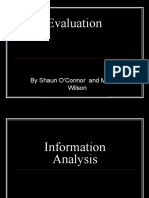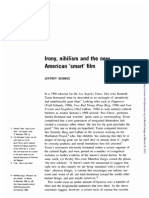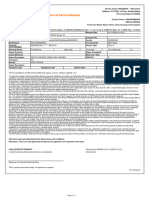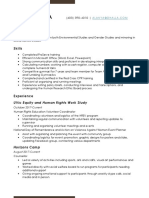International Business
International Business
Uploaded by
Aarti GajulCopyright:
Available Formats
International Business
International Business
Uploaded by
Aarti GajulOriginal Description:
Original Title
Copyright
Available Formats
Share this document
Did you find this document useful?
Is this content inappropriate?
Copyright:
Available Formats
International Business
International Business
Uploaded by
Aarti GajulCopyright:
Available Formats
MARATHA MANDIRS BABASAHEB GAWDE INSTITUTE OF MANAGEMENT STUDIES MMS-II SEMESTER-III FINANCE SUBJECT: INTERNATIONAL BUSINESS PRODUCT: SWEETS
COUNTRY: CANADA SUBMITTED TO: Prof. C.S. BALASUBRAMANIAM SUBMITTED BY: Name Mandar Deshmukh Aarti Gajul Tanoj Patidar Nayantara Sable Prashant Shedge Roll No. 12 18 41 51 55
ABOUT CANADA:Canada is a North American country consisting of ten provinces and three territories. Located in the northern part of the continent, it extends from the Atlantic Ocean in the east to the Pacific Ocean in the west, and northward into the Arctic Ocean. Spanning over 9.9 million square kilometres, Canada is the world's second-largest country by total area, and its common border with the United States is the longest land border in the world. The land that is now Canada was inhabited for millennia by various groups of Aboriginal peoples. Beginning in the late 15th century, British and French expeditions explored, and later settled, along the region's Atlantic coast. France ceded nearly all of its colonies in North America in 1763 after the Seven Years' War. In 1867, with the union of three British North American colonies through Confederation, Canada was formed as a federal dominion of four provinces. This began an accretion of provinces and territories and a process of increasing autonomy from the United Kingdom. This widening autonomy was highlighted by the Statute of Westminster 1931 and culminated in the Canada Act 1982, which severed the vestiges of legal dependence on the British parliament. Canada is a federal state that is governed as a parliamentary democracy and a constitutional monarchy with Queen Elizabeth II as its head of state. It is a bilingual nation with both English and French as official languages at the federal level. One of the world's most highly-developed countries, Canada has a diversified economy that is reliant upon its abundant natural resources and upon trade particularly with the United States, with which Canada has had along and complex relationship. It is a member of the G7, G8, G20, NATO, OECD, WTO,Commonwealth of Nations, Francophonie, OAS, APEC, and UN. With the sixth-highestHuman Development Index globally, Canada has one of the highest standards of living The name Canada comes from the St. Lawrence Iroquoian word kanata, meaning "village" or "settlement".[10] In 1535, indigenous inhabitants of the present-day Quebec City region used the word to direct French explorer Jacques Cartier to the village of Stadacona.[11] Cartier later used the word Canada to refer not only to that particular village, but also the entire area subject to Donnacona (the chief at Stadacona); by 1545, European books and maps had begun referring to this region as Canada.
In the 17th and early 18th centuries, "Canada" referred to the part of New France that lay along the Saint Lawrence River and the northern shores of the Great Lakes. The area was later split into two British colonies, Upper Canada and Lower Canada. They were re-unified as the Province of Canada in 1841. Upon Confederation in 1867, Canada was adopted as the legal
name for the new country, and the word Dominion was conferred as the country's title. However, as Canada asserted its political autonomy from the United Kingdom, the federal government increasingly used simply Canada on state documents and treaties, a change that was reflected in the renaming of the national holiday from Dominion Day to Canada Day in 1982.
Aboriginal people in Canada:Archaeological and genetic studies have indicated a human presence in the
northern Yukon region from 26,500 years ago, and in southern Ontario from 9,500 years ago. The Paleo-Indian archaeological sites at Old Crow Flats and Bluefish Caves are two of the oldest sites of human habitation in Canada. The characteristics of Canadian Aboriginal societies included permanent settlements, agriculture, complex societal hierarchies, and trading networks. Some of these cultures had collapsed by the time European explorers arrived in the late 15th and early 16th centuries, and have only been discovered through archaeological investigations. The aboriginal population is estimated to have been between 200,000 and two million in the late 15th century, with a figure of 500,000 accepted by Canada's Royal Commission on Aboriginal Health. Repeated outbreaks of European infectious diseases such as influenza, measles, and smallpox, combined with other effects of European contact, resulted in a forty- to eightypercent population decrease among aboriginal peoples in the centuries after the European arrival. Aboriginal peoples in Canada include the First Nations, Inuit, and Mtis. The Mtis are a mixed-blood people who originated in the mid-17th century when First Nations people and Inuit married European settlers. The Inuit had more limited interaction with European settlers during the colonization period.
ABOUT US: We are manufacturers, retailers and exporters of Sweets. We offer the cleanest and best quality products Treating every individual customer as a very special and meeting their requirements to the best possible satisfaction is our motto. Its a matter of pride that we produce more than 200 items everyday.
Canada facts: Name: Canada Type of government: Westminster style federal parliamentary democracy within a constitutional monarchy. Capital: Ottawa, Ontario. Administrative divisions: Ten provinces and three territories National holiday: Canada Day, July 1. Constitution: Westminster system, based on unwritten conventions and written legislation. Suffrage: Citizens aged 18 years or older. Participation in international organizations Description of national flag Elections Currency: 1 Canadian $ = 49.3038 Rs. Head of state: Elizabeth II, Queen of Canada
Viceroy: David Lloyd Johnston, Governor General of Canada Head of government Prime Minister Stephen Harper
Area: 9.9 million sq km (3.8 million sq miles) Major languages: English, French (both official) Major religion: Christianity Main exports: Machinery and equipment, automotive products, metals and plastics, forestry products, agricultural and fishing products, energy products
GNI per capita: US $43,270 (World Bank, 2010) Internet domain: .ca International dialing code: +1
Political environment Type of Government Two dominant political parties in Canada Canada has a federal parliamentary democracy within a constitutional monarchy. Canadian politics have not operated through revolutionary, swift changes. India and Canada have always had a healthy trade relationship. Thus , political environment is also favorable and there will not be any major issues as far as the government is concerned. Economic environment Gross National Product: $760 Purchasing power parity(per capita): $29,400
One of the wealthiest nations of the world, Canadas economy is dominated by service sector. Canadian inflation rate rose less than expected in December, ending the year at 2.4% January 25, 2011
Canadas banking segment is also quite conservative in comparison to the United States. Social environment Income Schooling Gender Social class: 3 to 5% of Canadians fall into this class.
The Upper Class
Upper-uppers
One percent belongs to an upper-upper level distinguished
Lower-uppers
The remaining 2-4% falls into the lower-upper level and
The Middle Class
Roughly 40-50% of the Canadian population falls into this category.
The Working Class
This class comprises about one-third of the population
The Lower Class
The remaining 20% of our population is identified as the lower class.
Cultural environment
Established in 1867 as a nation without war or rebellion, Canadians are most likely to be described as friendly, peaceful, polite, modest. They have a unique culture and deeply rooted values and traditions and though they enjoy cordial relations with their neighbor; the United States; they are not Americans. They love to laugh , often at their own expense, since they dont always take themselves too seriously. Language: Creativity: Attitudes and Values: Religion: Family structure: Legal environment Main laws Civil Law Common law Others Areas of law
Technological aspect Internet Digital Courts Digital Communication / HD TV (Delivery)
Environmental aspect
Canadian Environmental Protection Act Duties includes the preservation and enhancement of the quality of the natural environment, including water, air and soil quality; renewable resources, including migratory birds and other non-domestic flora and fauna; water; meteorology; the enforcement of any rules or regulations made by the International Joint Commission; and the coordination of the policies and programs of the Government of Canada respecting the preservation and enhancement of the quality of the natural environment.
Import procedures: Registering for an Import/Export Account Import tariffs Navigating the Border Warehousing or Storing your Shipment
Mode of entry:-
Licensing Registering business Marketing, Advertising and Sales Regulations Human resources regulations Hiring requirements Health and safety regulations Environmental regulations Importing regulations
STP ANALYSIS:Segmentation: Canadian English Canadian French Indo Canadian (East Indian) Caribbean Canadian (West Indian)
Targeting: East Indian or Indo - Canadian Indo Canadian are also known as NRIs in India According to Statistics in 2006, there were 962,665 people who consider themselves as being Indo-Canadians. The majority of the religious population:-
1. Sikhs 2. Hindus 3. Buddhists
Positioning: Indian Flavors. Competitive pricing. Fresh Products. Sweets made with pure desi ghee. Wide variety of products.
Marketing Mix:Product:Price mix:$5.00/lb -Jalebi $5.50/lb -Laddo $6.00/lb -Besan Burfi Besan Laddo $7.50/lb -Chumchum(cococnut ontop),Chumchum(yello),Gulab Jamun(black,coconut ontop) ,Gulab jamun(red,coconut ontop) Gur Shakar Paray Patha Rusgulla(small) Rusgulla(large)
$8.00/lb Patisa Pini $8.50/lb Badam Burfi (badam on top) Coconut Burfi(yellow) Coconut Burfi Dilbar Gazrella Gazrella Burfi (orange & white) Kalakand Pakiza Pera
Pista Burfi (green) Pista Burfi (white w/pista inside) Pista Burfi (pista on top) Plain Burfi Sandwich (white) Sandwich (yellow) $9.50/lb Milk Cake Umerty $10.00/lb Kaju Burfi (diamond shape) Kaju Kaser (yellow diamond shape) Kaju Kaser (round roll) Kaju Kaser Pista (pan shape) Kaju Pista (flat roll) $12.00/lb Badam Yellow Sandwich Chocolate Sandwich Kamal Phull Kashmir Sandwich Kesar Vatti Lacha Sandwich Malai Sandwich Orange Sandwicj Phull Pakiza Pineapple Sandwich Pink Sandwich Pista Sandwich
12 Types of mixed, colourful and decorated Bengali sweets to choose from. Mixed with Paneer, Khoya, Cream, Pista, Coconut, Cherries and a few mixed items.
$13.00/lb Kaju Apple(pista inside) Kaji Heart(pista inside) Kaji Guzia(half moon shape) (pista inside) Kaji Tikki
Promotion: Advertising Sales Promotional Activities Display Publicity
Process: Dine in Take away
Home delivery Telephone Internet
People:-
Customer Care
Cashier
Chef
Counter Sales
Physical evidence: Sample tasting of sweets Indian dcor Employee dress code: white safari suit with pagdi Excellent customer service Special discounts on account of Indian festivals Special packs
Logistics: Outsourcing logistics activities from Overseas Express Consolidators Canada Inc. The OEC Group has grown from one office in Montreal, Canada to become one of the leading logistics providers from Asia to North America spanning 60 countries and in over 230locations
Competitors: Surati Sweet Mart Indian Punjabi Bazaar Royal India Sweets & Restaurant
SWOT Analysis Strength Indian Taste Specialty TQM approach Sugar free sweets Pure vegetarian sweets Customization
Weakness Foreign environment. Catering only to Indians. Perishable commodity. High Calorie products. Import Implications.
Opportunities Untapped market Favorable Business Environment Less competition Easy regulation in starting operation Can obtain Tariffs subsidies in licensing.
Threats Competition from existing players Threat of new entrant Probability of disliking various flavors. Change in Import Policies.
CASE STUDY:GLOBAL HRM AT COLGATE PALMOLIVE CO. Facts: Colgate-Palmolive is the $ 6 billion a year personal products giant, earns nearly two-third of its revenues outside the United States. Rapidly changing business environment. To develop as a transnational orientation. Develop an international cadre of executive managers.
Steps taken: Recruitment of college graduates in 1987 24 months training in US Introduction of new product or revamping the existing one Euro-managers
You might also like
- 2 Storey Residential1Document12 pages2 Storey Residential1luffy88% (8)
- German F1Document396 pagesGerman F1ASRB87100% (7)
- VW 10540-1Document4 pagesVW 10540-1Carlos AraujoNo ratings yet
- Costa Rica - Culture Smart!: The Essential Guide to Customs & CultureFrom EverandCosta Rica - Culture Smart!: The Essential Guide to Customs & CultureNo ratings yet
- Vocabulary About Parts of Body, Food and DrinkDocument6 pagesVocabulary About Parts of Body, Food and DrinkZhansaya AmanbaykyzyNo ratings yet
- CANADA - PPTX Exposicion EnglishDocument20 pagesCANADA - PPTX Exposicion EnglishMaria Paula NaranjoNo ratings yet
- Some Information About CanadaDocument16 pagesSome Information About CanadaProttoy HaqueNo ratings yet
- Business Environment: Presentation 1 (LO3) - The Macro Environmental FactorsDocument30 pagesBusiness Environment: Presentation 1 (LO3) - The Macro Environmental FactorsNishaNo ratings yet
- Exploring the Diverse Landscapes and Cultures of Canada: From Sea to SkyFrom EverandExploring the Diverse Landscapes and Cultures of Canada: From Sea to SkyNo ratings yet
- Canada PresentationTPMSZDocument15 pagesCanada PresentationTPMSZSunshineMiriNo ratings yet
- Gabriel E. Garcia 12-2 English Class Country of CanadaDocument7 pagesGabriel E. Garcia 12-2 English Class Country of Canadagaby92009No ratings yet
- Canada - Culture Smart!: The Essential Guide to Customs & CultureFrom EverandCanada - Culture Smart!: The Essential Guide to Customs & CultureNo ratings yet
- Presented By: Gurunath Khade Rahul Bhalerao Girish Gupta Vikas Mishra Priyanka RamtekeDocument50 pagesPresented By: Gurunath Khade Rahul Bhalerao Girish Gupta Vikas Mishra Priyanka Ramtekeminakshi_kishoreNo ratings yet
- CanadaDocument2 pagesCanadaKkipkorir . SNo ratings yet
- Ethnic Diversity: Level of Personal FreedomDocument10 pagesEthnic Diversity: Level of Personal FreedomTOI 1802No ratings yet
- Geography: Development of Canadian CultureDocument4 pagesGeography: Development of Canadian CultureAlbert EnglisherNo ratings yet
- SampleDocument10 pagesSampleadjutant25sqnNo ratings yet
- Canada: An Overview: Demographic FeaturesDocument9 pagesCanada: An Overview: Demographic Featuresmanmohan100% (4)
- Geographical PositionDocument7 pagesGeographical Positionqwerty uiopNo ratings yet
- Culture of CanadaDocument6 pagesCulture of CanadaValy IleaNo ratings yet
- ISC Handbook For International Students ENcanDocument52 pagesISC Handbook For International Students ENcanfchukwuemezie568No ratings yet
- Culture of CanadaDocument16 pagesCulture of CanadaNawara IANo ratings yet
- 5Document86 pages5blue busNo ratings yet
- Canadian CultureDocument9 pagesCanadian Cultureklmk100% (5)
- English Speaking Countries (Canada)Document1 pageEnglish Speaking Countries (Canada)sevaraNo ratings yet
- British CommonwealthDocument6 pagesBritish CommonwealthНазерке ҚалдыбайқызыNo ratings yet
- CanadaDocument22 pagesCanadaK-pop. Fan.No ratings yet
- Topic 1: Canadian Government Power On New ImmigrantsDocument6 pagesTopic 1: Canadian Government Power On New Immigrantsapi-280339229No ratings yet
- Canada-Ana Acevedo-7°Document2 pagesCanada-Ana Acevedo-7°ᴀɴᴀ ᴍᴀʀɪᴀ ᴀᴄᴇᴠᴇᴅᴏNo ratings yet
- Trabalho CanadaDocument12 pagesTrabalho CanadabernardotdarosaNo ratings yet
- By Monika Mittal Richa Chaudhry Isha Kaushik Nitin Batra Nikhil PahwaDocument30 pagesBy Monika Mittal Richa Chaudhry Isha Kaushik Nitin Batra Nikhil PahwaMonika MittalNo ratings yet
- CanadaDocument5 pagesCanadahov.umtNo ratings yet
- Canada: Identity Summary of CanadaDocument14 pagesCanada: Identity Summary of CanadaImran CheemaNo ratings yet
- Canada Living GuideDocument126 pagesCanada Living Guidesha.pratibha2016No ratings yet
- Canada Is A cou-WPS OfficeDocument1 pageCanada Is A cou-WPS OfficetamurrasolyNo ratings yet
- CanadaDocument14 pagesCanadasahil.bali2024No ratings yet
- CanadaDocument29 pagesCanadaejectmailNo ratings yet
- Canada: Navigation SearchDocument22 pagesCanada: Navigation SearchNatalieTalamoniukNo ratings yet
- Exposición de CanadáDocument11 pagesExposición de CanadáKAREN ANNETTE ALANIZ COL�NNo ratings yet
- Majestic Mountains CANADADocument2 pagesMajestic Mountains CANADACécile DERCKELNo ratings yet
- Instituto Técnico de Exalumnos Salesianos Technical/Cultural Exposition XxxiDocument11 pagesInstituto Técnico de Exalumnos Salesianos Technical/Cultural Exposition XxxiDan DiazNo ratings yet
- Culture of Canada: From Wikipedia, The Free EncyclopediaDocument42 pagesCulture of Canada: From Wikipedia, The Free EncyclopediaMd Nazmus SakibNo ratings yet
- Ap Da CambridgeDocument2 pagesAp Da Cambridgebeatriz.pocinho16No ratings yet
- Red Blue Beige Vintage Creative Scrapbook Group Project Presentation PDFDocument9 pagesRed Blue Beige Vintage Creative Scrapbook Group Project Presentation PDFmpybpvhvhsNo ratings yet
- Anglais ArticlesDocument8 pagesAnglais ArticlesbalouamdsNo ratings yet
- Final PresentationDocument18 pagesFinal Presentationmrbajwa550No ratings yet
- Canadian Citizenship Exam (Notes)Document16 pagesCanadian Citizenship Exam (Notes)mashibani01No ratings yet
- Geographical Position: Canada HistoryDocument2 pagesGeographical Position: Canada HistoryАнна МакароваNo ratings yet
- Canada ADocument23 pagesCanada AschlunkeloineNo ratings yet
- Generalities of CanadaDocument7 pagesGeneralities of CanadaScribdTranslationsNo ratings yet
- Canadá Trabalho de InglêsDocument6 pagesCanadá Trabalho de InglêsJoyce Da CruzNo ratings yet
- Casi Casi Q Me PagoDocument52 pagesCasi Casi Q Me PagoomnimusicoNo ratings yet
- A Project Report: Titled A Study On The Country "Canada"Document57 pagesA Project Report: Titled A Study On The Country "Canada"Deepika ManchandaNo ratings yet
- Canada - History, Population, Immigration, Capital, & Currency - BritannicaDocument12 pagesCanada - History, Population, Immigration, Capital, & Currency - BritannicamelukellenNo ratings yet
- Business Environment of CanadaDocument38 pagesBusiness Environment of CanadaPalmodiNo ratings yet
- Canada: Is A Country in North America Consisting of 10 ProvincesDocument18 pagesCanada: Is A Country in North America Consisting of 10 ProvincesEmilyn Mata Castillo100% (1)
- Cosa RisaDocument23 pagesCosa RisalarimarumNo ratings yet
- History in CanadaDocument3 pagesHistory in CanadaMd. Mostafizur RahmanNo ratings yet
- What's Canada's Climate Like?Document6 pagesWhat's Canada's Climate Like?Надія ПогодаNo ratings yet
- Canada 2Document9 pagesCanada 2mrbajwa550No ratings yet
- Developed MarketDocument4 pagesDeveloped MarketAastha MishraNo ratings yet
- Trans-Cultural Values Week 4 Culturalvalues of CanadaDocument10 pagesTrans-Cultural Values Week 4 Culturalvalues of CanadaGenEsis CarandangNo ratings yet
- The CanadiansDocument3 pagesThe Canadiansdirgahometuition4No ratings yet
- QuestionnaireDocument6 pagesQuestionnaireAarti GajulNo ratings yet
- TreasuryDocument23 pagesTreasuryAarti GajulNo ratings yet
- Session 3: Dr. M.A. GanachariDocument1 pageSession 3: Dr. M.A. GanachariAarti GajulNo ratings yet
- Indusind BankDocument19 pagesIndusind BankAarti GajulNo ratings yet
- EEFC AccountDocument4 pagesEEFC AccountAarti GajulNo ratings yet
- EEFC AccountDocument4 pagesEEFC AccountAarti GajulNo ratings yet
- Non Fund Based ServicesDocument1 pageNon Fund Based ServicesAarti GajulNo ratings yet
- Indusind Bank:-Fund Based Services (FB) Working Capital FinanceDocument2 pagesIndusind Bank:-Fund Based Services (FB) Working Capital FinanceAarti GajulNo ratings yet
- Group Conflicts & Group Decision Making: Thank YouDocument1 pageGroup Conflicts & Group Decision Making: Thank YouAarti GajulNo ratings yet
- Submit Ted T O: Prof - Gaurav RathodDocument16 pagesSubmit Ted T O: Prof - Gaurav RathodAarti GajulNo ratings yet
- Cost & Management Accounting: A Report On Following TermsDocument17 pagesCost & Management Accounting: A Report On Following TermsAarti GajulNo ratings yet
- Cost and Management Accounting: Presented To:-Prof. M.A.GanachariDocument10 pagesCost and Management Accounting: Presented To:-Prof. M.A.GanachariAarti GajulNo ratings yet
- Dairy IndustryDocument17 pagesDairy IndustryAarti GajulNo ratings yet
- Data ProcessingDocument4 pagesData ProcessingAarti Gajul0% (1)
- HRM Notes Bms - Co.inDocument5 pagesHRM Notes Bms - Co.inAarti GajulNo ratings yet
- C F C P S (CS61063) : Tutorial 1Document13 pagesC F C P S (CS61063) : Tutorial 1brahma2deen2chaudharNo ratings yet
- Brochure Sample1Document2 pagesBrochure Sample1api-533738398No ratings yet
- History Past PaperDocument12 pagesHistory Past PaperLkey KeysNo ratings yet
- Claremont COURIER 3-17-17Document32 pagesClaremont COURIER 3-17-17Peter WeinbergerNo ratings yet
- 40 Best Exercises To Increase HeightDocument51 pages40 Best Exercises To Increase HeightGaudencio BoniceliNo ratings yet
- SecuritiesIndustryNews 101507Document3 pagesSecuritiesIndustryNews 101507shekarmNo ratings yet
- KR-1W IS-600 III: Wave-Front Analyzer Ophthalmic UnitDocument10 pagesKR-1W IS-600 III: Wave-Front Analyzer Ophthalmic UnitSamir BenounaNo ratings yet
- 7 Gates To The Grapes of Blessings: LessingDocument6 pages7 Gates To The Grapes of Blessings: LessingUloko ChristopherNo ratings yet
- Fe Del Mundo Was Born in Manila On November 27Document2 pagesFe Del Mundo Was Born in Manila On November 27Dannica Ignacio AbsalonNo ratings yet
- Louis Vyner Performance Competition Final RoundDocument14 pagesLouis Vyner Performance Competition Final Roundfachry hafidzNo ratings yet
- I.Objectives: Drama-Techniques Types-Of-Dramatic-Devices/ Literary-Techniques-IntertextualityDocument4 pagesI.Objectives: Drama-Techniques Types-Of-Dramatic-Devices/ Literary-Techniques-IntertextualityMiss JulyNo ratings yet
- Module Hand BookDocument14 pagesModule Hand BookAbdul WahidNo ratings yet
- Dr. Natasha Baker ResumeDocument2 pagesDr. Natasha Baker ResumeFOX54 News HuntsvilleNo ratings yet
- Steam Condenser - Lecture SlideDocument43 pagesSteam Condenser - Lecture SlideKing KNo ratings yet
- The AwakeningDocument2 pagesThe AwakeningStellaNo ratings yet
- Syllabus DFM Latest PDFDocument1 pageSyllabus DFM Latest PDFNAVEEN KUMAR S NNo ratings yet
- TVSM GET 2 JD-OOG-Territory Manager-Sales (2 Wheeler)Document3 pagesTVSM GET 2 JD-OOG-Territory Manager-Sales (2 Wheeler)Neeraja AtukuriNo ratings yet
- Olimpiade Bahasa Inggris SDDocument4 pagesOlimpiade Bahasa Inggris SDBelajar Berbicara Bahasa Inggris100% (1)
- Decreeing Your Jubilee - StoneDocument90 pagesDecreeing Your Jubilee - Stonefaithwalker101100% (2)
- E3 UoE Unit 2Document11 pagesE3 UoE Unit 2Alonso NietoNo ratings yet
- Evaluation: by Shaun O'Connor and Matthew WilsonDocument33 pagesEvaluation: by Shaun O'Connor and Matthew WilsonmattwilsonmediaNo ratings yet
- Prince 2 BrochureDocument9 pagesPrince 2 Brochurebhargav ramNo ratings yet
- Irony, Nihilism and The New American 'Smart' FilmDocument21 pagesIrony, Nihilism and The New American 'Smart' FilmAlex Reid100% (1)
- Page 1 of 1Document1 pagePage 1 of 1Indrajith GINo ratings yet
- Alanya Dhalla: University of VictoriaDocument3 pagesAlanya Dhalla: University of Victoriaapi-401176993No ratings yet
- Crop ProtectionDocument14 pagesCrop ProtectionWala LangNo ratings yet


